Blepharitis is one of the most common eye (eyelid) condition in the world: almost everyone suffers from it at some point in their life, and it has been understood to be the cause of repeated styes and chalazia . Patients with Blepharitis usually complain of crusty, red, swollen, eyelids that burn, itch, and cause a foreign body sensation in the eyes when they blink (“like having sand in the eyes”). 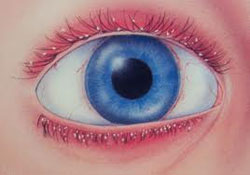 In severe (chronic) cases, overtime people even lose their eyelashes from this condition. It has been associated with a very common skin condition called “Acne Rosacea,” (https://health.google.com/health/ref/Rosacea) where people suffer from redness of the skin on their cheeks, nose, chin, foreheads, and eyelids, which present as these “spider-like” blood vessels with occasional skin eruptions similar to acne.
In severe (chronic) cases, overtime people even lose their eyelashes from this condition. It has been associated with a very common skin condition called “Acne Rosacea,” (https://health.google.com/health/ref/Rosacea) where people suffer from redness of the skin on their cheeks, nose, chin, foreheads, and eyelids, which present as these “spider-like” blood vessels with occasional skin eruptions similar to acne.
One thing that is extremely important about Blepharitis is that it has been linked to a very high increase in one’s risk of developing a devastating eye infection (Endophthalmitis) after eye surgery (Cataract Surgery, Glaucoma Surgery, Retinal Surgery, LASIK Surgery, and even after routine injections to treat Macular Degeneration). In fact, the number one recommendation to prevent endophthalmitis in patients undergoing eye surgery worldwide is to “identify and treat blepharitis before surgery.
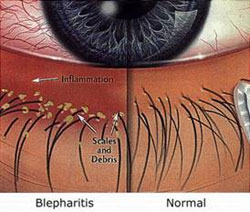
The following links provide more detailed literature about the risks of infection in the face of blepharitis.
There are basically two different types of blepharitis: Anterior (Staphylococcal vs. Seborrheic), and Posterior (Meibomian Gland Dysfunction), and it is certainly possible (and common) to have different kinds of blepharitis at the same time.
Seborrheic Blepharitis
The first type is due to a bacterial (Staphylococcal) overgrowth at the eyelid margins, where the bacteria can actually be seen on people’s eyelashes as these small white flaky debris (called Colarettes).
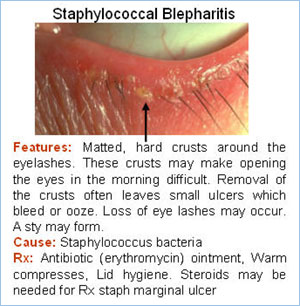
Staphylococcal Blepharitis
The second type is called “Seborrheic Blepharitis” This condition is a continuation of a dermatologic condition called “Seborrheic Blepharitis” that affects the eyelids, and these “greasyrdquo; (seborrheic) flakes can easily be visualized on people’s eyelashes even with the naked eye.
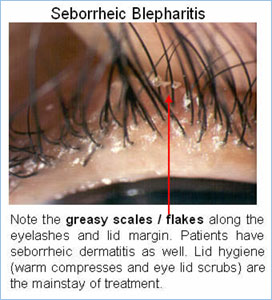
Blepharitis
The third type of blepharitis is due to poor eyelid hygiene and “backed up” oil inside the Meibomian Glands (Meibomian Gland Dysfunction) where ones eyelids turn red and inflamed. It must be noted that this type of blepharitis has been associated with Acne Rosacea which is an extremely common dermatologic condition.
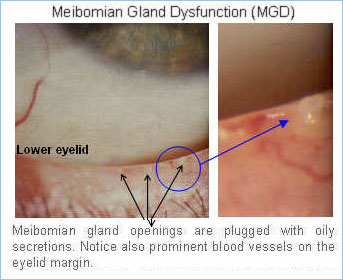
There have been dozens of book chapters and hundreds of articles written specifically about blepharitis and its treatment, and the treatment to this day remains the same: improved eyelid hygiene, the use of topical and systemic antibiotics, and possible topical steroids.
Lid hygiene can be easily achieved by applying eye-pressesTM, and massaging the affected eyelids with the pre-moistened pads; this obviates the need to clean the eyelid margins with cotton-tipped applicators (e.g., Q-tips) and baby shampoo.
Lid massage consists of pushing on the meibomian glands at the lid margin with in a rotary action toward the lid margin to express the meibomian gland contents, which have melted during the warm compresses step. The decision to treat blepharitis with a topical (e.g., Ophthalmic Erythromycin or Bacitracin Ointment), oral antibiotic (e.g., Doxycycline), or topical steroids (e.g., Prednisolone drops) should be left to your eye-care professional.

